January 31, 2011 – 04:17 am EST
The march higher continued for the first part of last week and it looked as though the concerns that were raised in our last newsletter were unfounded. Then on Friday the market took a big hit that saw QQQQ down over 2.5% on the day and end flat for the week. This is a change from the typical action over the last 5 months but not all was bad, let take a closer look…
***We grow by word of mouth, if you like this newsletter then please share it.
.
ETF % Change Comparison
.

The main thing you will notice from the numbers above is that SMH managed to advance 2.05% and is 2.08% off its high while QQQQ advanced 0.09% and is 2.54% off its high. It is very impressive when SMH can show relative strength like this and if it continues then any profit taking can be considered a buying opportunity.
.
Learn more – ETF % Change Comparison
.
![]()
.
A Look at the Charts
.
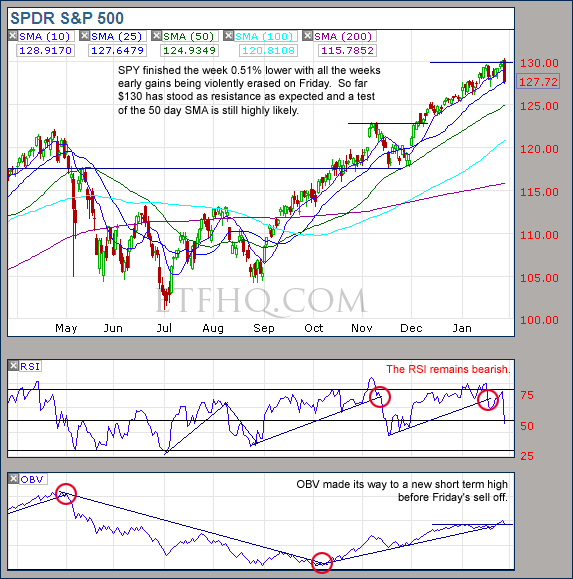
SPY has strong resistance at $130, still expecting a test of the 50 day SMA.
.
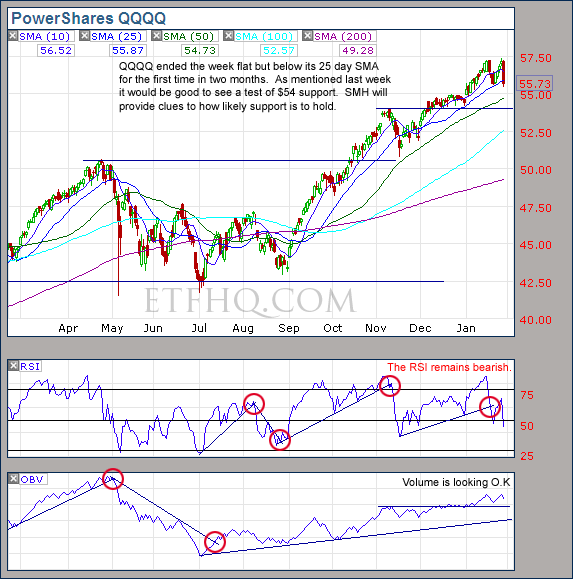
It would be good to see a test of $54, keep an eye on SMH for relative performance.
.
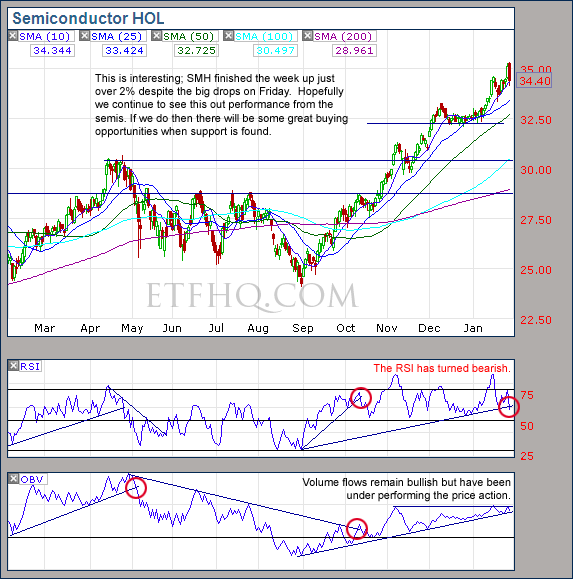
A little more selling from SMH will cause a trend change in volume and a likely test of the 50 Day SMA.
.
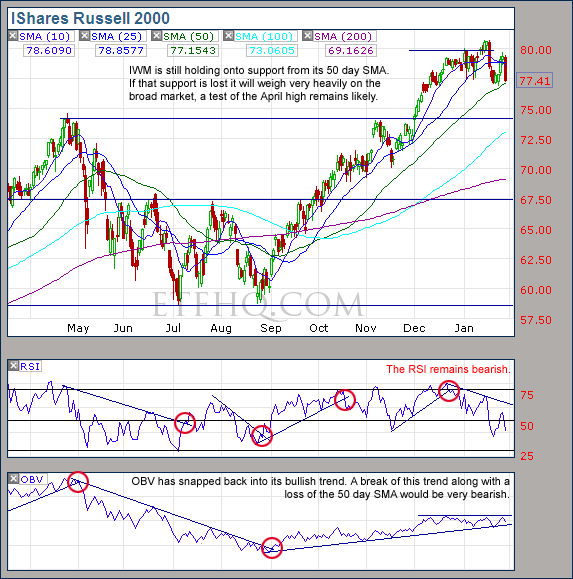
Key support at test here on IWM, keep an eye on the 50 day SMA.
.
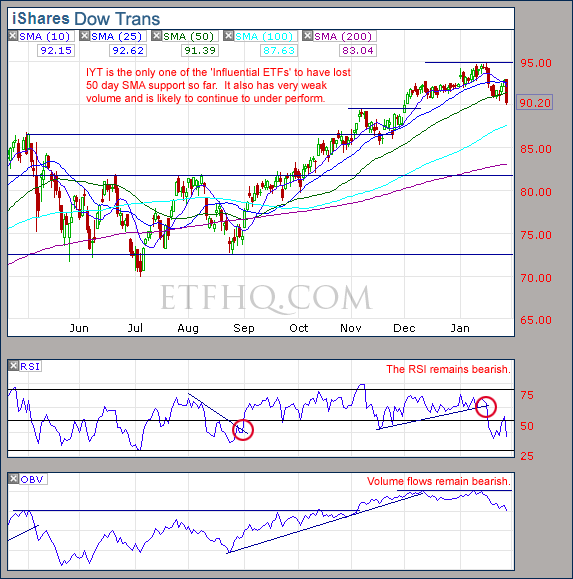
The Transports have weak volume and have broken through support, not a safe place to be.
.
![]()
.
OM3 Weekly Indicator
.

The buy signals remain active after more than 5 months but the ‘bear alerts’ warn that the weekly cycle continues to slow.
Learn more – The OM3 Indicator
.
![]()
.
TransDow & NasDow
.

The Dow remains dominant over both the NASDAQ and the Transports and both systems remain in cash. Historically the market has been very unproductive while the Dow was been dominant.
.
What the TransDow Readings tell us:
The TransDow measures dominance between the DJ Transportation Index (DJTI) and the Dow Jones Industrial Average (DJIA). In a strong market the more economically sensitive Transportation Index should be dominant over the DJIA.
Historically the DJTI has been dominant over the Dow 45% of the time. The annualized rate of return from the DJTI during this period was 18.47% with the biggest loss for one trade sitting at -13.27%. The annualized return from the DJIA during the periods it was dominant over the DJTI was just 4.06% and the biggest loss for one trade was -16.13%. A 4% stop-loss is applied to all trades adjusting positions only at the end of the week.
What the NasDow Readings tell us:
The NasDow measures dominance between the NASDAQ and the DJIA. Using the same theory behind the Trans Dow; in a strong market the more economically sensitive NASDAQ should be dominant over the DJIA.
Historically the NASDAQ has been dominant over the DJIA 44% of the time. Taking only the trades when the NASDAQ is above its 40 week moving average the annualized rate of return was 25.47% with the biggest loss for one trade sitting at –8.59%. The annualized rate on the DJIA during the periods it was dominant over the NASDAQ is just 8.88% and the biggest loss for one trade was –12.28%. A 8% stop-loss is applied to all trades adjusting positions only at the end of the week.
.
![]()
.
LTMF 80 & Liquid Q
.

LTMF 80 continues to hold an open position in QQQQ and is currently showing a profit of 16.35%. Liquid Q remains in cash.
.
Historical Stats:
.

.
How The LTMF 80 Works
LTMF stands for Long Term Market Forecaster. It reads volume flows relative to price action and looks for out performance of volume measured on a percentage basis over the prior 12 months. During a sustained rally the readings will reach high levels (near 100%) making it imposable for the volume reading to always outperform price so any reading above 80% will maintain the buy signal. This system has outperformed the market over the last 10 years but performance has been damaged by some nasty losses. It only produces buy signals and only for QQQQ.
How Liquid Q Works
Liquid Q completely ignores price action and instead measures the relative flow of money between a selection of economically sensitive and comparatively stable ares of the market. It looks for times when the smart money is confident and and can be seen by through volume investing heavily is more risky areas due to an expectation of expansion. This system has outperformed the market over the last 10 years and remained in cash through most of the major declines. It only produces buy signals and only for QQQQ. We will provide more performance details on the web site for these systems soon.
.
![]()
.
Summary
Volume flows over the last week favored the bulls as nearly all the selling occurred on just one day (Friday). SMH also displayed some great strength in the face of that selling which is another positive sign. Plus, with the exception of IYT, there have not yet been any major support levels lost. This would suggest that what we are seeing is a bit if healthy profit taking but I will be monitoring the situation closely for any more sinister signs.
Any disputes, questions, queries, comments or theories are most welcome in the comments section below.
.
Cheers
Derry
And the Team @ ETF HQ
“Equipping you to win on Wall St so that you can reach your financial goals.”
.
![]()
.
Quote of the Day:
“What are the differences between Mark Zuckerberg and me? Let’s take a look. I give you private information about corporations for free and I’m a villain. Mark Zuckerberg gives your private information to corporations for money and he’s Man of the Year.” – Bill Hader’s Julian Assange